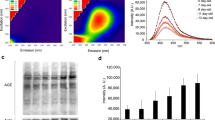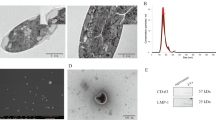Abstract
This paper demonstrates that the aging and death of nematodes, which is accompanied by the emission of a blue glow under a fluorescent microscope, are not directly associated with either lipofuscin (aging pigment) or with anthranilic acid (degradation product of tryptophan residues). It turns out that the parasitic light scattered on the worm cuticle and organs substantially contributes to the blue fluorescence of live and dead nematodes, as well as to blue flashes in dying worms. In spectrofluorimetry, anthranilic acid contributes greatly to the fluorescence in the blue region; however, its overall content measured by this method relative to the total protein amount is, conversely, lower in adult individuals than in younger ones. Artificial aging by heating did not lead to anthranilic acid accumulation. Aging of the nematode seems to result from strong cross-linking among the proteins. The tryptophan fluorescence and light scattering in homogenates favor this suggestion, since old worms have a large amount of denatured proteins, which can be observed by the long-wave shift in the tryptophan fluorescence. Moreover, large cross-linked protein particles that cannot be destroyed by detergents can be observed according to the light scattering.
Similar content being viewed by others
References
Belyakovich, A.G., Izuchenie mitokhondrii i bakterii s pomoshch’yu soli tetrazoliya p-NTF (Analysis of Mitochondria and Bacteria Using Tetrazolium Salt p-NBT), Pushchino: Nauch. Tsentr Biol. Issled., 1990.
Vekshin, N.L., Flyuorestsentnaya spektroskopiya biopolimerov (Fluorescence Spectroscopy of Biopolymers), Pushchino: Foton-Vek, 2009.
Vekshin, N.L., Frolova, M.S., Kovalev, V.I., and Begunova, E.A., Tyndall’s hypochromism in suspensions, Biophysics (Moscow), 2015, vol. 60, no. 1, pp. 101–106
Vekshin, N.L. and Frolova, M.S., Artifacts of confocal microscopy, Biophysics (Moscow), 2014, vol. 59, no. 5, pp. 843–847
Minullina, R.T., Fakhrullin, R.F., and Ishmukhametova, D.G., Caenorhabditis elegans in toxicology and nano-toxicology, Vestn. Voronezh. Gos. Univ., Ser.: Khim., Biol., Farm., 2012, no. 2, pp. 172–176
Ovcharenko, D., Marusich, E., Lashmanova, E., et al., Possible use of new PI3K inhibitors for life elongation using C. elegans as a model, V Mezhdunarodnaya konferentsiya “FiztekhBio,” Tezisy dokladov (V Int. Conf. “FiztekhBio,” Abstracts of Papers), Dolgoprudnyi, 2015, pp. 84–86
Frolova, M.S., Surin, A.M., Braslavski, A.V., and Vekshin, N.L., Degradation of mitochondria to lipofuscin upon heating and illumination, Biophysics (Moscow), 2015, vol. 60, no. 6, pp. 934–939
Abou-Zied, O.K. and Al-Busaidi, B.Y., Husband solvent effect on anthranilic acid spectroscopy, J. Phys. Chem. A, 2014, vol. 118, no. 1, pp. 103–109
Brunk, U.T. and Terman, A., The mitochondrial-lysosomal axis theory of aging: accumulation of damaged mitochondria as a result of imperfect autophagocytosis., Eur. J. Biochem., 2002, vol. 269, pp. 1996–2002
Coburn, C., Allman, E., Mahanti, P., et al., Anthranilate fluorescence marks a calcium-propagated necrotic wave that promotes organismal death in C. elegans, PLoS Biol., 2013, vol. 11, no. 7, pp. 1–10
Donato, H. and Sohal, R.S., Age-related changes in lipofuscin-associated fluorescent substances in the adult male housefly Musca domestica, Exp. Gerontol., 1978, vol. 13, nos. 3–4, pp. 171–179.
Fattoretti, P., Bertoni-Freddari, C., Casoli, T., et al., Morphometry of age pigment lipofuscin and of ceroid pigment deposits associated with vitamin E deficiency, Arch. Gerontol. Geriatr., 2002, vol. 34, no. 3, pp. 263–268.
Gerstbrein, B., Stamatas, G., Kollias, N., and Driscoll, M., In vivo spectrofluorimetry reveals endogenous biomarkers that report health span and dietary restriction in Caenorhabditis elegans, Aging Cell, 2005, vol. 4, pp. 127–132
Garigan, D., Hsu, A.L., Fraser, A.G., et al., Genetic analysis of tissue aging in Caenorhabditis elegans: a role for heat-shock factor and bacterial proliferation, Genetics, 2002, vol. 161, pp. 1101–1107
Höhn, A. and Grune, T., Lipofuscin: formation, effects and role of macro-autophagy, Redox Biol., 2013, vol. 1, pp. 140–144
Hosokawa, H., Ishii, N., Ishida, H., et al., Rapid accumulation of fluorescent material with aging in an oxygen- sensitive mutant mev-1 of Caenorhabditis elegans, Mech. Ageing Dev., 1994, vol. 74, pp. 162–166
Ichimura, Y., Takao, T., Satomi, Y., et al., A ubiquitinlike system mediates protein lipidation, Nature, 2000, vol. 408, no. 6811, pp. 488–492
Jung, T., Bader, N., and Grune, T., Lipofuscin: formation, distribution, and metabolic consequences, Ann. N.Y. Acad. Sci., 2007, vol. 1119, pp. 97–111
Marzabadi, M.R., Sohal, R.S., and Brunk, U.T., Effect of a-tocopherol and some metal chelators on lipofuscin accumulation in cultured neonatal rat cardiac myocytes, Anal. Cell Pathol., 1990, vol. 2, no. 6, pp. 333–346.
Mizushima, N., Noda, T., Yoshimori, T., Tanaka, Y., et al., A protein conjugation system essential for autophagy, Nature, 1998, vol. 395, pp. 395–398
Nowotny, K., Jung, T., Grune, T., and Hohn, A., Accumulation of modified proteins and aggregate formation in aging, Exp. Gerontol., 2014, vol. 59, pp. 3–12
Pincus, Z., Mazer, T.C., and Slack, F.J., Autofluorescence as a measure of senescence in C. elegans: look to red, not blue or green, Aging (N.Y.), 2016, vol. 8, no. 5, pp. 889–898
Schutt, F., Ueberle, B., Schnölzer, M., et al., Proteome analysis of lipofuscin in human retinal pigment epithelial cells, FEBS Lett., 2002, vol. 528, nos. 1–3, pp. 217–221.
Shulkin, D.J. and Zuckerman, B.M., Spectrofluorometric analysis of the effect of centrophenoxine on lipofuscin accumulation in the nematode C. elegans, Age, 1982, vol. 5, pp. 50–55
Terman, A. and Brunk, U.T., Lipofuscin: mechanisms of formation and increase with age, APMIS, 1998, vol. 106, no. 2, pp. 265–276
Terman, A. and Brunk, U.T., On the degradability and exocytosis of ceroid/lipofuscin in cultured rat cardiac myocytes, Mech. Ageing Dev., 1998, vol. 100, no. 2, pp. 145–156
Vekshin, N.L., Photonics of Biopolymers, Berlin: Springer-Verlag, 2002.
Zglinicki, T., Nillson, E., Docke, W.D., and Brunk, U.T., Lipofuscin accumulation and aging of fibroblasts, Gerontology, 1995, vol. 41, no. 2, pp. 95–108
Zuckerman, B.M. and Himmelhoch, S., Nematodes as models to study aging, in Nematodes as Biological Models, Vol. 2: Aging and Other Model Systems, Zuckerman, B.M., Ed., New York: Academic, 1980, part 1, pp. 3–28.
Author information
Authors and Affiliations
Corresponding author
Additional information
Original Russian Text © E.L. Gagarinskyi, N.L. Vekshin, 2017, published in Uspekhi Gerontologii, 2017, Vol. 30, No. 5, pp. 676–684.
Rights and permissions
About this article
Cite this article
Gagarinskyi, E.L., Vekshin, N.L. Blue Death of Nematodes. Adv Gerontol 8, 163–169 (2018). https://doi.org/10.1134/S2079057018020042
Published:
Issue Date:
DOI: https://doi.org/10.1134/S2079057018020042




